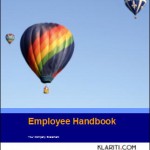Writing Engaging Employee Handbooks
Posted on September 1, 2011
Filed Under Business, Technology, The Writing Life | Leave a Comment
Ever been asked to write an employee handbook? That’s a special challenge because you’re writing on behalf of an organization for the people whose enthusiasm, support and creativity are vital to its success. They don’t cotton to legalese or strictures. An effective handbook needs to be more than simply a recitation of rules. We’re talking, in effect, about technical writing with a human face.
 In this context, we’ve come across a website – klariti.com – with a page on “How to Make Employee Handbooks More Human.” It’s selling an employee handbook template, but it’s modestly priced ($9.99) and might be good to have on hand. Beyond that, though, Ivan Walsh, the writer, has some pertinent tips for putting an engaging handbook together.
In this context, we’ve come across a website – klariti.com – with a page on “How to Make Employee Handbooks More Human.” It’s selling an employee handbook template, but it’s modestly priced ($9.99) and might be good to have on hand. Beyond that, though, Ivan Walsh, the writer, has some pertinent tips for putting an engaging handbook together.
First off (and this is where many projects seem to begin these days), he suggests heading to Google, entering the term “employee handbook” and downloading samples that appeal to you. Sure enough, there are lots of entries for either generic or actual handbooks to consider, many for downloading in the form of PDF files.
Walsh advises capturing the parts of the various manuals that you and your team find most interesting either in an old-fashioned file folder or on Evernote, a free web filing app. Then pick two three as most pertinent to your own project.
Approach the whole design, Walsh urges, in a personalized manner. You’re writing to be read and for your organization to be well-regarded, not merely coped with. “Share values not rules” is a Walsh stricture, because “Values are positive. Rules are (perceived as) negative. Open the document with an outline of what the company holds dear…” A statement of its vision and values would go nicely here.
Include stories, Walsh continues. Call them anecdotes if you prefer, but provide examples of desired corporate conduct that everyone in the organization can relate to. Explaining why you have these values in terms of customer or regulatory relationships is advisable.
Next is a Walsh tip that you don’t often see in handbooks – include input from employees themselves. “Approach employees personally and ask them to share something that makes them enjoy working at the company. It doesn’t have to be ‘epic’, just something that others can relate to.”
Including employee experiences can provide immediate verification and validation of a company’s aims and preferred manner of doing business. The manual, says Walsh, becomes “a living document.”
And, of course, he adds: Remember to include pictures. How many manuals that you recall would have been helped greatly by some photos to illustrate and enliven the work settings you’re promoting?
Employee handbooks don’t need to be tedious recitals of rules and processes. They can be engaging invitations to function creatively and responsibly at work. That, indeed, ought to be your aim in envisioning the handbook you’ve been asked to produce. – Doug Bedell
Comments
Leave a Comment
If you would like to make a comment, please fill out the form below.
Recently
- Presentations With Forethought
- Technical Writing’s Lineage – Surely It’s Deeper than Digital
- At the Holidays, Twitting Amazon
- Successful Cookie Baking – From Mom, an Acknowledged Expert
- Slides for a Tech Writer’s Craft
- Digital or Not, Be Clear
- Being Watchful About Digital Designs…
- When Proposals Don’t Click, Keep Making Them Anyway
- Like a Good Gardener, Help an Enterprise Keep Itself Current
- We’re Leaders All, And Need to Think That Way
Categories
Archives
- January 2017
- December 2016
- November 2016
- October 2016
- September 2016
- August 2016
- July 2016
- June 2016
- May 2016
- April 2016
- March 2016
- February 2016
- January 2016
- December 2015
- November 2015
- October 2015
- September 2015
- August 2015
- July 2015
- June 2015
- May 2015
- April 2015
- March 2015
- February 2015
- January 2015
- December 2014
- November 2014
- October 2014
- March 2014
- February 2014
- January 2014
- December 2013
- November 2013
- October 2013
- September 2013
- August 2013
- July 2013
- June 2013
- May 2013
- April 2013
- March 2013
- February 2013
- January 2013
- December 2012
- November 2012
- October 2012
- September 2012
- August 2012
- July 2012
- June 2012
- May 2012
- April 2012
- March 2012
- February 2012
- January 2012
- December 2011
- November 2011
- October 2011
- September 2011
- August 2011
- July 2011
- June 2011
- May 2011
- April 2011
- March 2011
- February 2011
- January 2011
- December 2010
- November 2010
- October 2010
- September 2010
- August 2010
- July 2010
- June 2010
- May 2010
- April 2010
- March 2010
- February 2010
- January 2010
Blogroll